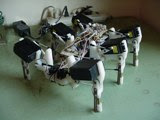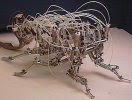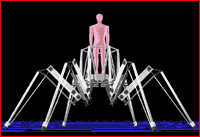
This six-legged mobile robot was a research platform I built to
investigate reactive robotic architectures. The work won the
Third Place Grand Award at the Intel International Science and
Third Place Grand Award at the Intel International Science and
Engineering Fair. The robot had over 2,000 components, 21 motors,
and 10 processors and was built during my senior year in high school.
and 10 processors and was built during my senior year in high school.
The robot is very similar in design to Attila and Hannibal, designed
and built by Colin Angle and Rod Brooks at the MIT AI Lab.
This project was completed in May, 1992.
http://www.cs.berkeley.edu/~prabal/projects/index.html
and built by Colin Angle and Rod Brooks at the MIT AI Lab.
This project was completed in May, 1992.
http://www.cs.berkeley.edu/~prabal/projects/index.html
3D Modelling for beginners : Hexapod Robot

Here is a step by step design guide which will help you from
next time convert your drawings or ideas into 3D models
which are a better representation and also good to look .
For the purpose of explaining the use we have chosen to
build a model of a Hexapod . So if you can use ms paint
you can do this .
next time convert your drawings or ideas into 3D models
which are a better representation and also good to look .
For the purpose of explaining the use we have chosen to
build a model of a Hexapod . So if you can use ms paint
you can do this .
LARA

I eventually decided upon a design whereby the 6 legs were
divided into three pairs, with each pair being joined by top and
bottom beams. The legs were sat on ball-bearing thrust races
to reduce friction and allow the robot to turn easier.
divided into three pairs, with each pair being joined by top and
bottom beams. The legs were sat on ball-bearing thrust races
to reduce friction and allow the robot to turn easier.
Hexapod Robot2

The hexapod robot developed by the Illinois hexapod group is
modeled after the American cockroach, Periplaneta americana.
We selected this insect as a model because of its extraordinary
speed and agility and because the structure and physiology of
modeled after the American cockroach, Periplaneta americana.
We selected this insect as a model because of its extraordinary
speed and agility and because the structure and physiology of
this insect are reasonably well known. The body of the robot measures
58 cm by 14 cm by 23 cm length, width, and height. It has an
additional 15 cm ground clearance when standing. The legs,
projecting laterally and to the front, add about 38 cm to the
width and 18 cm to the length. The robot weighs approximately
11 kg, most of the weight being in the valves that control the
pneumatic actuators. The physical dimensions of the robot body
and legs are generally between 12 and 17 times the size of the
58 cm by 14 cm by 23 cm length, width, and height. It has an
additional 15 cm ground clearance when standing. The legs,
projecting laterally and to the front, add about 38 cm to the
width and 18 cm to the length. The robot weighs approximately
11 kg, most of the weight being in the valves that control the
pneumatic actuators. The physical dimensions of the robot body
and legs are generally between 12 and 17 times the size of the
comparable dimensions of the cockroach. The robot, however,
is considerably heavier in relation to its size due to the weight
of the valves.
is considerably heavier in relation to its size due to the weight
of the valves.














